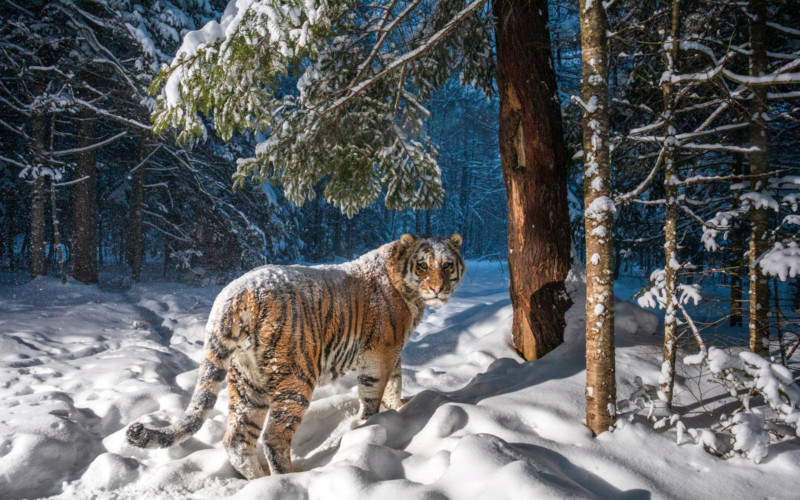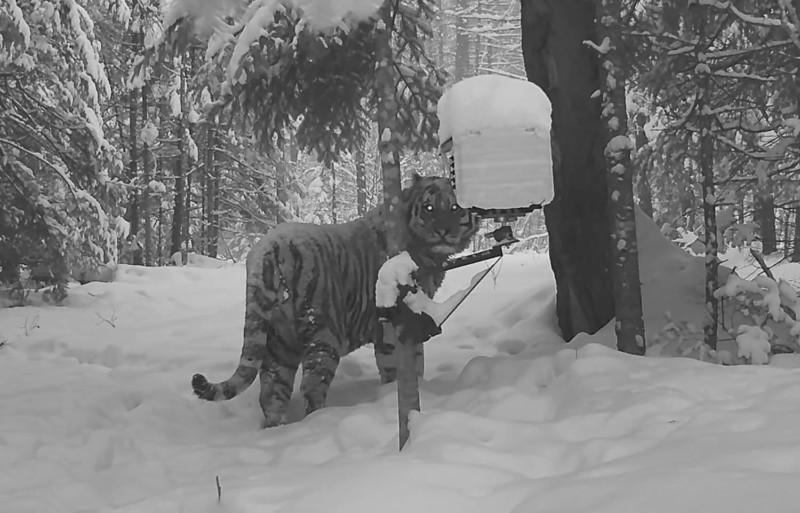Photographer Captures Photo of Rare Siberian Tiger
![]()
Wildlife photographer Sascha Fonseca has captured an incredible photo of the ultra-rare Siberian tiger in its snowy natural environment.

![]()
The resulting flash-lit photo shows the Siberian tiger pausing and looking into the lens as snow falls in the quiet forest.

“A male Siberian tiger passed by my camera trap deep in the forests of Far East Russia,” Fonseca says. “It turned out that it’s an unknown male which had not been documented yet. So, the researchers I work with during my camera trap project invited me to give him a name.”
In thinking of a name for the newly discovered creature, Fonseca noticed a particular marking on it that caused a name to pop into his head.
“We agreed on ‘Leo’ because of the distinctive L pattern on his left cheekbone, and after the famous Russian writer Leo Tolstoy,” the photographer says.
The Moment the Tiger Walked Into the Frame
A second camera nearby captured footage of the moment the Siberian tiger walked in front of Fonseca’s camera and turned to look at what was causing the flashes and shutter sounds.

The Siberian Tiger is Critically Endangered
The Siberian tiger is a tiger subspecies that is found primarily in the Far East of Russia, the Northeast of China, and North Korea. Other names for the Siberian tiger include the “Amur,” “Korean,” “Manchurian,” and “Ussurian” tiger — the choice of which name to use depends on the location where the tiger is spotted.
Once common in northeast Asia, widespread poaching of both the Siberian tiger and the prey animals they feed on has pushed the animal to the brink of extinction. It is estimated that less than 400 individuals remain in the wild.
“Approximately 350-400 adult Siberian or Amur tigers are left in the wild, with 95% of these individuals inhabiting the forests of the Russian Far East, where they play a critical role in both the ecosystem and local culture,” writes the Wildlife Conservation Society. “The tiger is a keystone species that requires large, intact forest ecosystems and acts as an indicator of overall ecosystem health […]
“Although poaching levels reached an estimated 60-70 tigers per year in the early 1990s, today Russian and international conservation efforts have succeeded in stabilizing the number of Amur tigers in the wild. However, there are still significant threats to this population, and the Amur tiger remains critically endangered.”

Fonseca is doing his part to ensure the Siberian tiger lives on. The German photographer has been using his photography skills to promote big cat conservation for years, and his current focus is specifically on the Siberian tiger.
“The very fact that there are wild Amur tigers in the world today is something of a miracle,” Fonseca says. “Only 3-4% of the area of an Amur tiger’s range are protected by wildlife reserves and national parks.
“Habitat loss, logging and mining, poaching, hunting, and a shrinking gene pool – the world’s largest cat clings to existence amidst a large number of interconnected problems.”
It is not just Siberian tigers that are at risk, though: tigers as a whole are endangered and on the International Union for Conservation of Nature’s Red List of Threatened Species, and it was estimated that there were less than 4,000 mature individuals in the world in 2015. Countries and organizations have launched new initiatives in recent years to protect the tiger, and the global tiger population has since increased to around 5,500 or more.
Image credits: All photographs, unless otherwise indicated, by Sascha Fonseca